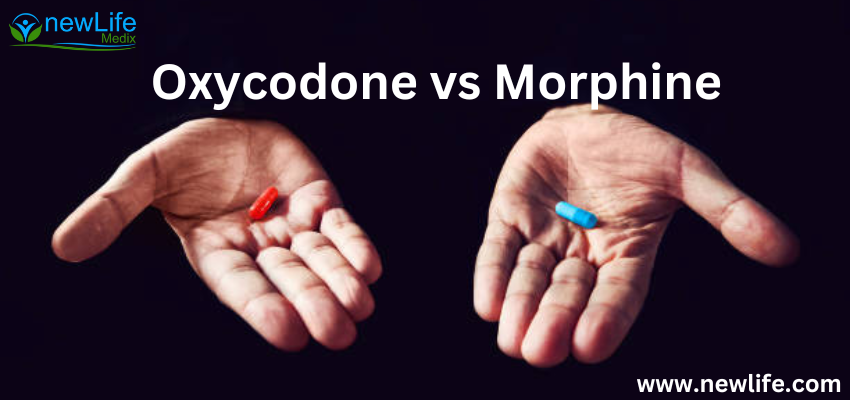Oxycodone as well as Morphine both are used as opioids. They are the prescription medicines used to treat acute moderate to severe pain. Despite being used for the same purposes, the medications are chemically very different which leads to their difference in course of action. In this article, we will be providing a detailed analysis of Oxycodone vs Morphine to help you understand better about both medicines.
But before starting keep in mind that if subjected to high power for misuse, they can lead to many adverse health consequences, dependence, and addictions.
We recommend pursuing effective therapy treatment if you or a loved one struggle with opioid abuse. This will help you gain the knowledge necessary to beat addiction, avoid relapse, and live a better, more satisfying life.
What is Oxycodone?
Oxycodone is an oral router medicine that is used to relieve severe pain. It is a combination of narcotic analgesics and oxycodone that act on the nervous system. First, it was developed in Germany in 1916 as less potent and addictive, which was more widely used for painkillers at that time.
It can generally take 3 to 5 hours for immediate release with food. If you take Oxycodone on a regular basis, it may become a habit formation or physical dependency.
What is Morphine?
Morphine is a prescription medicine that is used to relieve moderate to severe pain. It belongs to the group of medicines called narcotic analgesics (pain medicines) that directly acts on the central nervous system (brain and spinal cord). Morphine is a pain reliever.
Extracted from Opium, it is a non-synthetic narcotic that should not be taken if you have severe asthma issues, bowel obstruction, head injuries, alcohol addiction, or such issues.
What is the difference between Oxycodone and Morphine?
- Oxycodone is tend to have more severe high effects than Morphine. That is generally due to the strong composition of the drug that reacts vigorously.
- Oxycodone is a semisynthetic narcotic partial responder generated from the opioid alkaloid thebaine, and it is related to other phenanthrene derivatives like hydrocodone and morphine.
- In people, parenteral Morphine is somewhat more potent than injection Oxycodone. Although oral Oxycodone is more powerful than oral Morphine. Because Oxycodone metabolizes in a more predictable method than Morphine. Its dose adjustment is simpler.
- Compared to morphine, Oxycodone can be combined with other pain relievers such as acetaminophen or aspirin.
Common medicine applications include:
- Pain relief – They are used for the treatment of severe pain caused by conditions such as cancer, injury, and surgery.
- Chronic Pain – Treatment for chronic pain that is unresponsive to other drugs.
Doses & Uses: Oxycodone vs Morphine
The dosage and uses of Oxycodone and Morphine depend on each patient’s medical history, special conditions, and the type and level of pain they are facing. Both medications can be taken with or without food and are available as Immediate-Release (IR) and Extend-Release (ER) tablets.
Some Guidelines for Oxycodone Dosing & Uses Include:
- Dosage: Patients are normally recommended to take 5–15 mg of IR Oxycodone every 4-6 hours, or as needed, to relieve pain. The recommended dose for the ER form is 10-60 mg once or twice daily, up to a daily maximum of 288 mg, depending on the patient’s demands.
- Uses: Oxycodone should be taken orally, ideally with food, to avoid the stomach from upsetting. It can be consumed with or without water. It’s crucial to avoid crushing, chewing, or breaking IR or ER tablets because doing so could result in an excessive release of medication at once, which could have serious side effects or result in an overdose.
Some Guidelines for Morphine Dosing & Uses Include:
- Dosage: Patients are advised to consume 10–20 mg of IR morphine every four hours, or as needed, to relieve pain. Depending on the patient’s demands, this can range from 15-200 mg once daily for the ER formulation.
- Uses: Morphine may be given orally, intravenously, or through suppositories. The technique chosen is determined by the patient’s medical background, the type and degree of pain being treated, and other factors.
Side effects of Oxycodone and Morphine:
Some of the side effects of Oxycodone are as follows:
- High levels of serotonin in the body
- Breathing problems
- Slow heartbeat
- Vomiting
- Dizziness
- Constipation
Some of the side effects of Morphine are as follows:
- Chest pain, fast or hammering heartbeats, slow breathing
- Intense sleepiness that makes you feel like you might pass out
- Agitation, hallucinations, fever,
- Rapid heartbeat, muscle stiffness, twitching,
- Loss of coordination, nausea, and diarrhea
- Strong emotions of happiness or despair that are sudden to hit
The Price difference between Oxycodone and Morphine:
The cost of Oxycodone depends on which formulation (IR or ER), you purchase and also the dosage quantity. The average cost of 30 day supply of IR( Immediate-Relation) is 50 $ to 500 $ depending on the doses of the quality. Opposite to it, the cost of 30 day Morphine supply of IR tablets is from $30 to 300$, also based on the quantity.
It is important to remember that in a number of cases, protection from insurance and discounts or coupons can significantly reduce the cost of both Oxycodone and Morphine.
Wrap-Up:
With this we are wrapping the analysis of Oxycodone vs Morphine. Before starting the medicine keep in mind that both the medications are prone to sude-effects. It is just the matter of how your body reacts to the pills.
Read More:
Tapentadol vs Oxycodone: What’s the Difference?
How Long Does Oxycodone Stay In Your System? – 2023 Comprehensive Guide

